Cyber Incident Response Plan: Building Resilience Against Threats
Imagine waking up to find your business paralyzed by a cyber attack—sensitive data stolen, finances in turmoil, and your hard-earned reputation in jeopardy. This isn't just a nightmare; it's a reality for many companies today. Cybersecurity threats are evolving, becoming more sophisticated and relentless. In a high-stakes environment, having a cyber incident response plan isn't just a safety net—it's a lifeline.
Organizations need to be proactive and resilient and have a solid cybersecurity strategy in place to respond to cyberattacks effectively. Discover the different types of cyber attacks you need to prepare for, the steps you need to take during the process, and how to strengthen your cyber response plan.
8 Types of Cyber Attacks that Organizations Face
Understanding the various types of cyber attacks is crucial for developing effective defenses. In 2023, there was a 72% increase in data breaches since 2021, which held the previous all-time record. This increase is alarming, so it is important to know the types of cyber attacks that organizations may encounter:
- Phishing: Fraudulent attempts to obtain sensitive information by disguising it as a trustworthy entity via email or other communication channels. Learn how to spot phishing emails
- Ransomware: Malicious software that encrypts data and demands payment for its release, causing significant operational disruptions.
- Denial-of-Service (DoS): Overwhelms systems, servers, or networks with traffic, rendering them unavailable to intended users.
- Man-in-the-Middle (MitM): Intercepts and alters the communication between two parties without their knowledge, compromising data integrity.
- Malware: Various types of malicious software, including viruses, worms, and trojans, designed to damage or gain unauthorized access to systems.
- SQL Injection: Exploits vulnerabilities in an application’s software by inserting malicious SQL code into a query, allowing attackers to manipulate databases.
- Zero-Day Exploits: Attacks that target previously unknown vulnerabilities in software that developers have had no time to patch.
- Advanced Persistent Threats (APTs): Prolonged and targeted cyber attacks where an intruder gains access to a network and remains undetected for an extended period.
6 Important Steps to Take After Detecting a Cyber Attack
 When a cyber attack is detected, acting swiftly and efficiently is crucial to minimize damage and ensure a great recovery. Here are the important steps to take following your cyber incident response plan:
When a cyber attack is detected, acting swiftly and efficiently is crucial to minimize damage and ensure a great recovery. Here are the important steps to take following your cyber incident response plan:
- Identify and Assess the Attack: Determine the type, source, and scope of the attack. Analyze affected systems and data to understand the full extent of the breach and the methods used by the attackers.
- Contain the Attack: Implement immediate measures to prevent the attack from spreading. This might involve isolating compromised systems, disabling network access, or temporarily shutting down certain operations to contain the damage.
- Eradicate the Threat: Remove the malicious elements from your environment. This includes deleting malware, closing vulnerabilities, and eradicating any backdoors or persistent threats.
- Recover Systems and Data: Restore affected systems and data from clean backups. Validate the integrity and functionality of restored systems to ensure they are secure and fully operational before resuming normal activities.
- Communicate and Report: Maintain transparent communication with all stakeholders, including employees, customers, and regulatory bodies. Provide regular updates during the incident and a comprehensive report afterward detailing the attack, its impact, and the steps taken to mitigate and prevent future occurrences.
- Analyze and Learn: Conduct a thorough post-incident analysis to understand what went wrong and how it can be prevented in the future. Update your cybersecurity emergency response plan based on the lessons learned to strengthen your defenses against future attacks.
*If you're company is not equipped to identify, assess, contain, and eradicate the threat, Pulse recommends having this flyer available in your office for reference in the case of a cyber attack.
How Should Companies Prepare Their Cyber Incident Response Plan?
 Preparing involves proactive planning, regular cybersecurity awareness training, and continuous improvement. Companies should develop a comprehensive cyber incident response plan that outlines clear detection, containment, eradication, and recovery procedures. This plan should be regularly updated and tested through simulated attack scenarios to ensure its effectiveness.
Preparing involves proactive planning, regular cybersecurity awareness training, and continuous improvement. Companies should develop a comprehensive cyber incident response plan that outlines clear detection, containment, eradication, and recovery procedures. This plan should be regularly updated and tested through simulated attack scenarios to ensure its effectiveness.
Investing in strong cybersecurity measures, such as firewalls, intrusion detection systems, and encryption, is also crucial. Companies should conduct regular security audits and vulnerability assessments to identify and address potential weaknesses in their systems.
Employee training is another vital component. Educating staff about common cyber threats, such as phishing and social engineering, can significantly reduce the risk of a successful attack. Employees should know what to do after a cyber attack, including whom to contact and how to preserve evidence.
Creating a culture of cybersecurity awareness encourages everyone in the organization to be vigilant and proactive. According to IBM Security's 2023 Report, organizations with a strong security culture have an average data breach cost savings of $1.76 million compared to those without.
Combining these strategies allows companies to build a strong defense against cyber threats and ensure they are well-prepared to respond effectively if an attack occurs.
6 Things to Do to Continuously Improve Cyber Incident Response Plan
Continuous improvement of your cyber response plan is essential to stay ahead of evolving threats. Here are the key ways to achieve this:
- Regular Testing and Drills: Conduct frequent simulations and drills to identify weaknesses and improve response times. These exercises help ensure all team members are familiar with their roles and can act swiftly during a real incident.

- Update Policies and Procedures: Regularly review and update your response plan to reflect new threats and technological advancements. This keeps your strategy current and ensures you have the best strategy and weapon against cyber attacks.
- Incident Analysis: Analyze past incidents to learn from mistakes and enhance future response strategies. This process helps you understand what went wrong and how you can strengthen your defenses moving forward.
- Stay Informed: Keep up with the latest cybersecurity trends, threats, and best practices through continuous education and industry resources. Staying informed allows you to anticipate and counteract emerging threats more effectively.
- Collaboration: Engage with industry peers, cybersecurity experts, and organizations to share insights and improve your defenses. Collaborative efforts can provide new perspectives and enhance your cybersecurity system.
- Feedback Loop: Implement a feedback loop where employees can suggest improvements based on their experiences and observations during drills or actual incidents. This approach creates a culture of continuous improvement and encourages proactive involvement from all staff members.
Secure Your Future with an Effective Cyber Incident Response Plan
Cyberattacks are inevitable in the current digital era—it's only a question of when. Building a strong cyber incident response plan is essential to protecting your business from potentially devastating impacts. This involves not only having the right tools and technologies in place but also ensuring your team is well-prepared to respond swiftly and effectively.
Regularly updating and testing your response plan can make all the difference in minimizing damage and speeding up recovery. Don't leave your future to chance.
Our expert team is here to give you the best cybersecurity services and help develop a strong cyber attack response strategy for your specific needs. Contact us today, and let’s work together to secure your business against cyber threats and ensure you're always one step ahead.





